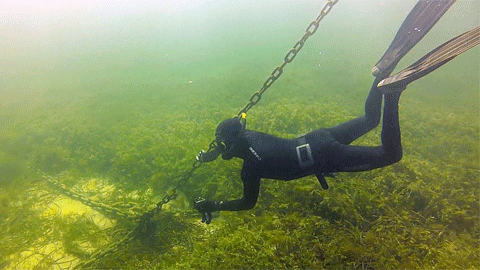Boat mooring chains scour Rottnest (Australia) seagrass releasing CO2

15/03/2016
The research published in the journal Nature: Scientific Reports surveyed the ‘scars’ created by mooring chains in the bays around one of Western Australia’s iconic tourist destinations.
Dr Oscar Serrano led the research with Professor Paul Lavery and Professor Pere Masque from the Edith Cowan University (ECU) and the Universitat Autònoma de Barcelona (ICTA-UAB and Department of Physics UAB), and said the movement of the chains scraped seagrass off the seafloor.
“As moored boats drift with the currents, wind and waves they drag a heavy chain across the seafloor and that chain acts just like a razor across the skin removing the seagrass,” said Oscar Serrano.
“But unlike a 5 o clock shadow – in this case the seagrass doesn’t grow back.
“Unfortunately these protected, calm bays favoured for boat moorings are also prime habitats for seagrass.”
Efforts to preserve seagrass meadows by using seagrass friendly mooring lines in some areas is resulting in the recovery of seagrass in some areas of the Island however overall seagrass covers is decreasing.
That’s because the size of mooring scars in Stark Bay on the Island’s north coast has increased about 500 per cent from 2,000sqm in 1980to 9,000 sqm today due to erosion of the already scarred areas by wave action.
“Once the mooring chains have started the process of scouring, waves will likely continue spreading those scoured areas.
“In Stark Bay, we’ve seen the scarred areas join up to become large areas devoid of any seagrass.”
The destruction of the seagrass meadows has important implications for the ecosystems of Perth’s favourite marine playground.
“Seagrass is an important habitat for many species of fish as well as a food source for dugong and turtles,” he said.
“More importantly in a global sense, seagrass absorbs carbon dioxide at more than 40 times faster than tropical rainforests.
“What that also means is that when the seagrass meadows are wiped out the carbon dioxide which has been absorbed over hundreds of years, is released back into the atmosphere.”
As part of this project, core samples were taken in the scarred areas and where seagrass still existed.
Those sample showed on average more than 75 per cent of carbon absorbed in those seagrass meadows was lost increasing atmospheric carbon dioxide.
Dr Serrano said it is important steps are taken to protect the seagrass meadows around Rottnest Island and the rest of Australia.
“These older style moorings have started to be replaced on Rottnest Island, but that needs to continue here and in other popular mooring sites,” he said.